756 Systems Engine, APU

Engine and APU Systems Knowledge Quiz
Test your knowledge of the 757 and 763 aircraft engine and APU systems with this detailed quiz! Whether you're a student, a pilot, or an aviation enthusiast, you'll find challenging questions that cover key operational principles and system fun
Key features of this quiz:
- Multiple choice questions
- Focus on critical engine and APU operations
- Perfect for training and certification preparation
1) 757/763: There are two engine idle speeds: minimum and approach idle. One way approach idle is activated automatically is when:
A) Trailing edge flaps are extended beyond position 20
B) Glideslope capture
C) Continuous ignition is selected to ON
D) Both throttles at idle and speed brakes are deployed
2) 757/763: Approach idle provides better engine acceleration for go-around or reverse thrust. After a ___ second delay following touchdown, the engines decelerate to minimum idle to minimize landing distance.
A) 3
B) 8
C) 5
D) 10
3) 763: When the engine is operating, the engine electronic engine control (EEC) is powered by:
A) Standby AC and DC busses
B) A dedicated permanent magnet alternator (PMA)
C) Left main AC bus
D) Hot battery bus
4) 757: Each engine electronic engine control (EEC) is powered by:
A) Dual dedicated generators (DDG)
B) Standby AC and DC busses
C) Left main AC bus
D) Hot battery bus
5) 764: Anytime the engine is running, the engine electronic engine control (EEC) is powered by:
A) Permanent magnet generator (PMG)
B) Standby AC and DC busses
C) Left main AC bus
D) Hot battery bus
6) 763: If both channels in an electronic engine control (EEC) fail, the associated engine will:
A) Revert to its backup system, hydro-mechanical operation
B) Maintain above idle speed
C) Decelerate to and remain at minimum fuel flow
D) Maintain its current speed until the associated EEC switch is placed in the OFF position
7) 757/763: How can continuous ignition and approach idle be selected without using the engine anti-ice switches?
A) By placing the wing anti-ice switch to ON
B) By selecting flap position 1, 5 or 15
C) By performing a normal approach
D) Both cannot be selected unless the engine anti-ice switches are selected on
8) 757: The thrust system consists of a hydromechanical engine fuel control with an electronic engine control (EEC) unit. Is any overspeed protection provided for the N2 rotor?
A) The N2 rotor has protection but only during reversing operations
B) There is no N2 overspeed protection
C) There is protection for the N2 rotor provided the EEC is operating normally
D) There is always N2 overspeed protection during all phases of engine operation
9) 764: If both channels in an electronic engine control (EEC) fail, the associated engine:
A) Reverts to hydro-mechanical operation
B) Reverts to the N2 control mode
C) Decelerates to and remains at minimum fuel flow
D) Performs an automatically controlled engine shutdown
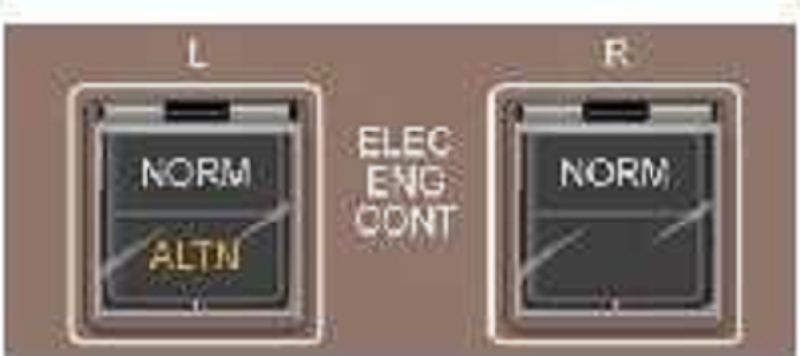
10) 767: According to the graphic, the left electronic engine control alternate mode (ALTN) switch light has illuminated. This indicates:
A) Automatic reversion or manual selection to the alternate mode
B) Reverse thrust has no overspeed protection
C) Maximum thrust red-line protection is no longer available
D) The EEC can no longer control engine speed and decelerates to and remains at minimum fuel flow
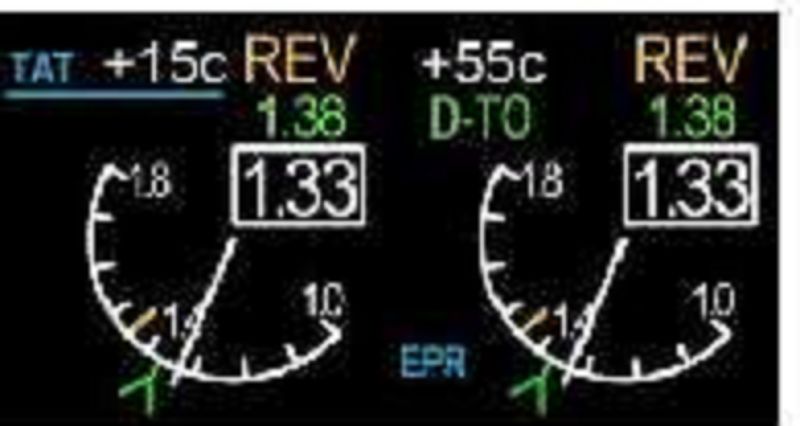
11) 757/763: What does the amber REV light displayed above each EPR indication indicate?
A) The reverser is fully retracted
B) The reverser is fully deployed
C) The reverser is in transit
D) A fault is detected in the reverser
12) 757: The thrust control system includes an electronic limiter control (ELC) unit. What is its primary purpose?
A) N2 overspeed protection
B) N3 overspeed protection
C) N1 overspeed protection
D) EPR overboost protection
13) 757: The thrust system consists of a hydromechanical engine fuel control with an electronic engine control (EEC) unit. The EEC sets thrust by controlling:
A) N1 based on thrust lever position
B) N2 based on thrust lever position
C) EPR based on thrust lever position
D) N3 based on thrust lever position
14) 757/763: The thrust management computer (TMC) calculates a reference _____ based on existing pressure altitudes and ambient temperature data from the air data system.
A) N3
B) N2
C) N1
D) EPR
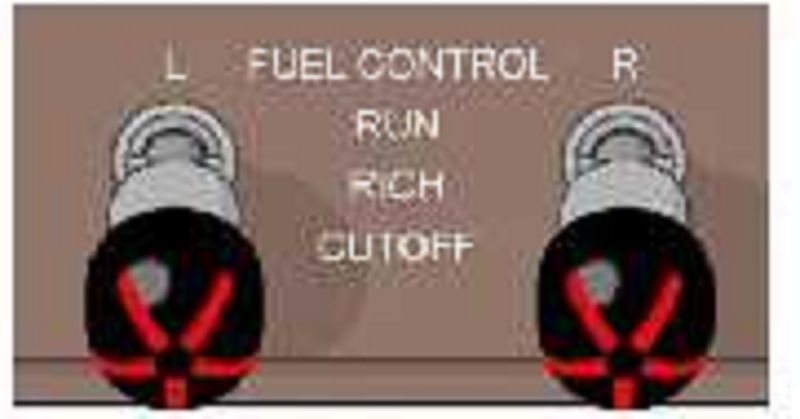
15) 757: The FUEL CONTROL switches have three positions: RUN, RICH, and CUTOFF. When should the RICH position be used during engine start?
A) EGT 0°
B) EGT > 0°
C) After an aborted engine start
D) EGT < 0°
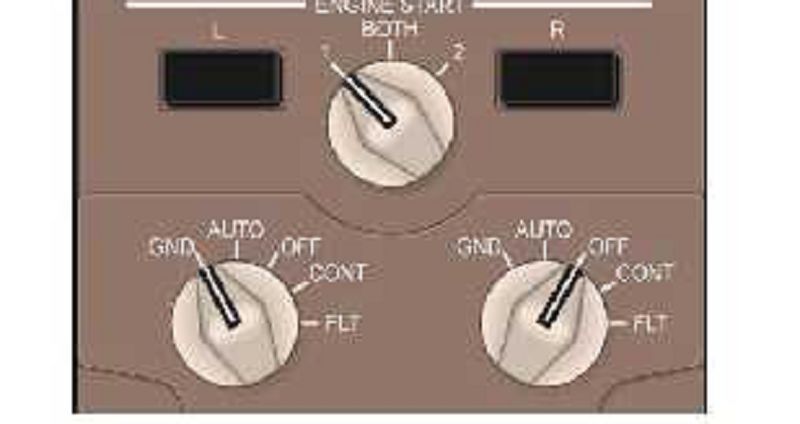
16) 757/767 When does the ENG START selector automatically move from the GND position to the AUTO position during engine start?
A) At approximately 51%
B) At approximately 50%
C) At approximately 47%
D) At approximately 45%
17) 757/767: Minimum idle is a lower thrust than approach idle and is selected:
A) When continuous ignition is selected ON
B) When the leading edge slats are extended
C) During ground operation and all phases of flight except approach and landing
D) When the engine anti-ice switches are positioned to OFF
18) 757/763: When the standby engine indicator (SEI) selector is _________ and both CRTs fail, engine indications will be displayed automatically.
A) Positioned to OFF
B) Positioned to AUTO or OFF
C) Positioned to AUTO
D) In any position as long as AC power is still available
19) 757/767: With the FUEL CONTROL switch out of CUTOFF, rotating the ENGINE START selector to the FLT position:
A) Causes selected ignition system for the associated engine to operate continuously
B) Causes an auto relight to be initiated automatically
C) Bypasses the ignition selector and causes both ignition systems to operate continuously
D) Bypasses the ignition selector and causes both ignition systems to operate continuously for 120 seconds
20) 757/767: During APU shutdown, the APU control system incorporates a time-delay feature. The time delay is variable from 0 to 120 seconds. Why is this feature incorporated?
A) To prevent AC electrical surges
B) To prevent rapid bleed air depressurization
C) To protect the unit from thermal shock
D) To allow time for the APU to position the variable guide vanes
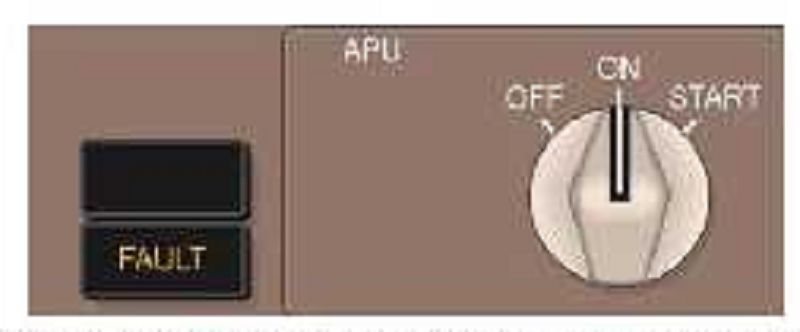
21) 757/767: According to the graphic, the APU FAULT light is illuminated. The light illuminates whenever a fault is sensed. In this situation, the APU will:
A) Automatically shut down
B) Shut down only after placing the selector to OFF and the time-delay feature is satisfied
C) Continue to run if the fault was sensed while airborne
D) Continue to run if the fault was detected on the ground
22) 757/767: During APU start and shutdown, the FAULT light illuminates momentarily. What causes its illumination?
A) The APU fuel valve is not in the commanded position
B) The APU DC fuel pump has failed
C) The APU battery voltage has dropped below a preset value
D) The APU control circuitry is starting up or shutting down
23) 757/767: During normal operations, APU shutdown incorporates a time-delay feature permitting APU cooling. When is the APU shut down automatically and the cool-down delay bypassed?
A) When AC power is unavailable, and the APU DC fuel pump fails
B) When the left forward fuel pump is selected off
C) For a fault or a fire
D) When one or both of the APU fire loops fail
24) 757/767: Although the primary purpose of the APU is to supply electrical power and bleed air on the ground before engine start, the APU can also be started inflight, and provide electrical power:
A) Throughout the aircraft operating envelope
B) Up to 17,000 feet
C) Up to 35,000 feet
D) Up to 41,000 feet
25) 757/767: Fuel is normally supplied to the APU from the left main fuel tank. Should conditions require, fuel can be supplied from:
A) The right main fuel tank only
B) Any fuel tank through the crossfeed system
C) The left main fuel tank only
D) The center fuel tank only
26) 757/767: While on the ground, turning the BAT switch off causes the APU to:
A) Shut down
B) Continue running, but the RUN light will no longer be visible
C) Continue running, but the APU selector will become unpowered
D) Shut down if external power is selected on
27) 757/767: In flight, APU bleed air is available up to approximately:
A) 41,000 feet
B) 35,000 feet
C) 17,000 feet
D) 43,000 feet
28) 757/767: The APU fuel valve fails to reach the commanded position during an APU start or shutdown, this is indicated by:
A) EICAS advisory APU FUEL VAL
B) APU FAULT light and flashing APU RUN light
C) APU fault light and EICAS advisory APU FUEL VAL
D) The APU FAULT light
29) 763: If a fault exists in the thrust reverser system, this will be indicated by:
A) A REV ISLN light on the center control pedestal and status message
B) A REV ISLN light on the center control pedestal and an EICAS advisory message REV ISLN VAL
C) An amber REV annunciation above each digital EPR indication
D) There are no indications shown when on the ground
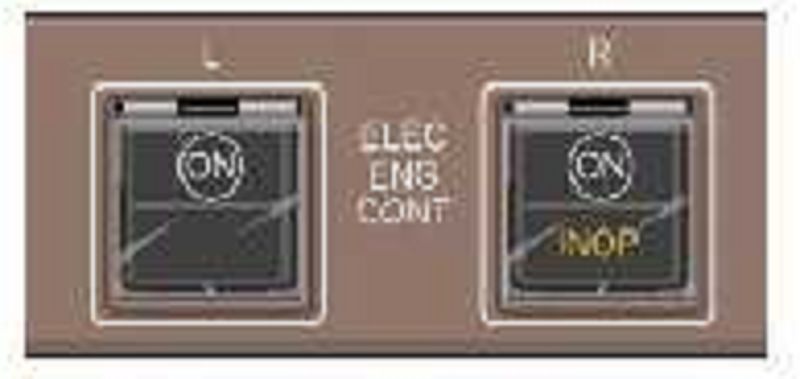
30) 757: According to the graphic, the R EEC INOP light is illuminated. This indicates:
A) A failure is detected but the EEC will still provide overboost protection
B) A failure is detected in the system and the EEC trim motor holds the current trim level until the unit is turned off
C) A failure is detected and overspeed protection is no longer provided
D) A failure is detected in the system and engine limit protection is not available
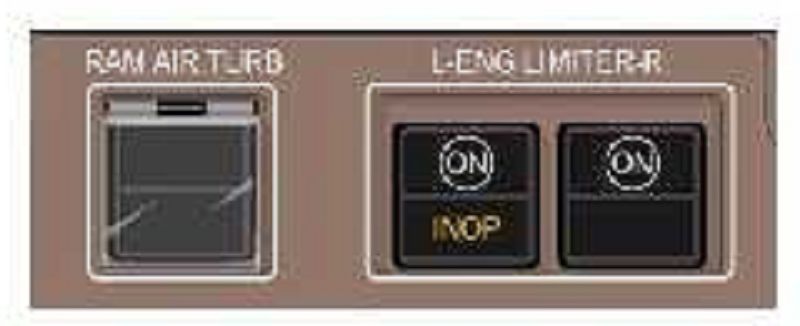
31) 757: According to the graphic, the L ELC INOP light is illuminated. This indicates:
A) A failure is detected in the system and engine limit protection is not available
B) A failure is detected and overboost protection is no longer provided
C) A failure is detected but the ELC will still provide N1 overspeed protection
D) A failure is detected in the system and the ELC will hold the current trim level until the unit is turned off

32) 757/763: When pushed, the maximum indication reset (MAX IND RESET):
A) Resets and blanks all overtemp and overspeed values stored in computer memory
B) Resets and blanks the reduced thrust setting to the maximum thrust value
C) Resets and blanks all standby engine indicator (SEI) maximum exceedance values
D) Resets and blanks all maximum exceedance values on EGT, N1, N2, and N3

33) 757/767: The magenta fuel on command bug is displayed. When is this bug shown?
A) Only on the ground when an engine is shutdown
B) Only inflight when the airspeed is greater than that for a windmilling start
C) Engine is shutdown on the ground, or inflight, when X-BLD is displayed
D) Only inflight when X-BLD is annunciated
34) 764/763(66XX): There are two engine idle speeds: minimum idle and approach idle. The EEC selects these idle speeds automatically. Rotating the ENGINE START selectors to _______ manually selects approach idle.
A) CONT
B) FLT
C) AUTO
D) OFF
35) 764: The ignition system includes an automatic relight feature. It is enabled in the air or on the ground if N2 drops below _____. If this occurs, the EEC will energize both ignition systems for the affected engine(s).
A) Idle speed
B) 20%
C) 10%
D) 30%
{"name":"756 Systems Engine, APU", "url":"https://www.quiz-maker.com/QPREVIEW","txt":"Test your knowledge of the 757 and 763 aircraft engine and APU systems with this detailed quiz! Whether you're a student, a pilot, or an aviation enthusiast, you'll find challenging questions that cover key operational principles and system functionalities.Key features of this quiz:Multiple choice questionsFocus on critical engine and APU operationsPerfect for training and certification preparation","img":"https:/images/course8.png"}
More Quizzes
756 Systems Flight Controls
1261022
Understanding Aircraft Fire Classes
11614
Maternity Pharmacology CH49 Gastrointestinal
126120
Which Commentary YouTuber Are You?
94629
Order Items from Most General to Most Specific - Free
201015978
RIASEC Test - Free Career Interests Online
201018577
Computer Parts You Can Touch - Name the Parts
201023345
Male Reproductive System - Test Your Knowledge
201019960
Cutie Mark: What Would Yours Be? Free Results
201016985
MLA Letter Format - Free Business Report Practice
201017697
Food Class Test - Level 2 Food Hygiene Practice (Free)
201017561
Animal In You: Which Animal Matches Your Personality
201017561